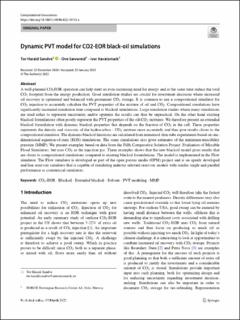| dc.contributor.author | Sandve, Tor Harald | |
| dc.contributor.author | Sævareid, Ove | |
| dc.contributor.author | Aavatsmark, Ivar | |
| dc.date.accessioned | 2022-06-13T13:10:34Z | |
| dc.date.available | 2022-06-13T13:10:34Z | |
| dc.date.created | 2022-05-30T13:53:23Z | |
| dc.date.issued | 2022 | |
| dc.identifier.citation | Computational Geosciences. 2022, . | en_US |
| dc.identifier.issn | 1420-0597 | |
| dc.identifier.uri | https://hdl.handle.net/11250/2998561 | |
| dc.description.abstract | A well-planned CO2EOR operation can help meet an ever-increasing need for energy and at the same time reduce the total CO2 footprint from the energy production. Good simulation studies are crucial for investment decisions where increased oil recovery is optimized and balanced with permanent CO2 storage. It is common to use a compositional simulator for CO2 injection to accurately calculate the PVT properties of the mixture of oil and CO2. Compositional simulations have significantly increased simulation time compared to blackoil simulations. Large simulation studies where many simulations are used either to represent uncertainty and/or optimize the results can thus be unpractical. On the other hand existing blackoil formulations often poorly represent the PVT properties of the oil-CO2 mixtures. We therefore present an extended blackoil formulation with dynamic blackoil properties that depends on the fraction of CO2 in the cell. These properties represents the density and viscosity of the hydrocarbon - CO2 mixture more accurately and thus give results closer to the compositional simulator. The dynamic blackoil functions are calculated from numerical slim-tube experiments based on one-dimensional equation-of-state (EOS) simulations. The same simulations also gives estimates of the minimum-miscibility pressure (MMP). We present examples based on data from the Fifth Comparative Solution Project: Evaluation of Miscible Flood Simulators, but uses CO2 as the injection gas. These examples shows that the new blackoil model gives results that are closer to compositional simulations compared to existing blackoil formulations. The model is implemented in the Flow simulator. The Flow simulator is developed as part of the open porous media (OPM) project and is an openly developed and free reservoir simulator that is capable of simulating industry relevant reservoir models with similar single and parallel performance as commercial simulators. | en_US |
| dc.language.iso | eng | en_US |
| dc.rights | Navngivelse 4.0 Internasjonal | * |
| dc.rights.uri | http://creativecommons.org/licenses/by/4.0/deed.no | * |
| dc.title | Dynamic PVT model for CO2-EOR black-oil simulations | en_US |
| dc.title.alternative | Dynamic PVT model for CO2-EOR black-oil simulations | en_US |
| dc.type | Peer reviewed | en_US |
| dc.type | Journal article | en_US |
| dc.rights.holder | © The Author(s) 2022 | en_US |
| dc.description.version | publishedVersion | en_US |
| cristin.ispublished | true | |
| cristin.fulltext | original | |
| cristin.qualitycode | 1 | |
| dc.identifier.doi | 10.1007/s10596-022-10133-x | |
| dc.identifier.cristin | 2028140 | |
| dc.source.journal | Computational Geosciences | en_US |
| dc.source.pagenumber | 15 | en_US |

